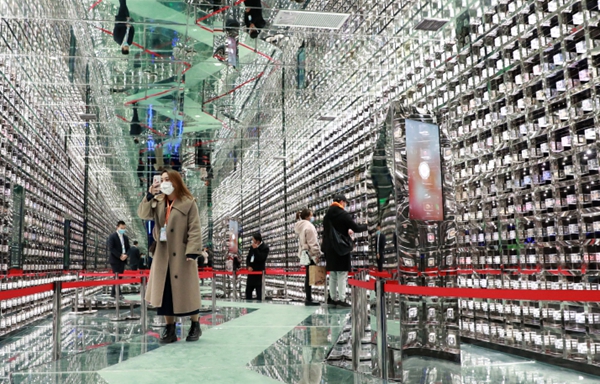China attaches more importance to seed industry to ensure food security
 0 Comment(s)
0 Comment(s) Print
Print E-mail Beijing Review, January 12, 2021
E-mail Beijing Review, January 12, 2021

"Ahard job that involves risk taking." That's how Li Hui described his profession, a description that brings to mind the image of a police officer. But he's not an officer; he's a researcher. Working in the seed industry for years, he said the long life cycle of seed development makes the job a tough one indeed.
By "risk taking" he refers to the uncertainties of success in the industry. "Unlike the production of industrial products, seed breeding is rife with uncertainties and success requires experience and luck," Li, a research assistant with the Chengdu Institute of Biology, Chinese Academy of Sciences (CAS), told Beijing Review. "Many professors fail to cultivate a fine variety even throughout their life."
Recently Li received media attention as the industry was brought into the spotlight by the Central Economic Work Conference held in December last year. Developing the industry has become one of the major tasks for 2021 because of its importance to China's food security.
Seed and food security
China's modern seed industry has yielded remarkable results, Tang Renjian, Minister of Agricultural and Rural Affairs, said recently during a visit to the Chinese Academy of Agricultural Sciences.
Tang said China is self-sufficient in the seeds of two main grain crops, rice and wheat, while the domestic supply of the seeds of corn and soybean is also guaranteed. Currently, the share of foreign-funded enterprises in China's seed market is 3 percent while imported seeds account for 0.1 percent of the country's seed consumption, according to him. In general, the seed supply is guaranteed and risks are controllable, he said.
China's rice seed breeding is a success story, Li said. The latest news about rice seed breeding was announced on December 28, 2020, which said that some of the rice seeds traveling around the Moon on board of the Chang'e-5 spacecraft sprouted and were ready for follow-up studies.
Since the founding of the People's Republic of China in 1949, rice seed breeding has made great progress, going from breeding by farmers to large-scale commercialized development and from natural selection to gene editing. Rice seed breeding has contributed to increase in total output and per unit yield of rice and to the country's food security. Moreover, new rice varieties that need less pesticide and chemical fertilizer have contributed to lowering pesticide residue and protecting the environment, Li said.
In recent years, rice varieties that can thrive in saline and alkaline fields have also been cultivated. .
The achievements in rice breeding have not only benefited people in China but also those in other countries.
Tu Shengbin, an associate research fellow at the Chengdu Institute of Biology, CAS, told Beijing Review that the application of hybrid rice techniques and improvements of equipment can help increase export of rice from Myanmar, Laos and Cambodia by a total of 20 million tons, accounting for half of the global rice trade volume.
Tu said there is a great potential for collaboration between China and participants of the Belt and Road Initiative in rice seed breeding.
Amid the novel coronavirus pandemic, such cooperation is especially important. "Some countries restrict crop export, especially during the novel coronavirus pandemic," Tu said. He believes that cooperation rather than restriction is the way to enhance food security.
Reducing import dependence
Although China is self-sufficient in the seeds of rice and wheat, it imports seeds of other grains and vegetables.
According to the Ministry of Agriculture and Rural Affairs, China imported $475 million worth of grain seeds and $228 million worth of vegetable seeds in 2018.
Li Jing, a research fellow with the Institute of Botany at CAS, told Beijing Review that although China is an agricultural country, its seed technology lags behind developed countries. "Quality gaps have resulted in higher prices of foreign seeds," she added.
Li Jing said overreliance on imported seeds will result in domestic growers' inability to bargain in the international market, which may lead to economic losses for large growers, and even the risk of seed source shortage. Measures must be taken to avoid the plight.
Germplasm resource is key to coping with the seed issues, as was mentioned at the Central Economic Work Conference. "The conservation and utilization of germplasm resources are key to independent innovation in seed breeding," Li Guoxiang, a researcher with the Rural Development Institute, Chinese Academy of Social Sciences, wrote in an article published in December 2020.
Li emphasized the building of seed banks. In the southern province of Hainan, a national comprehensive seed breeding base featuring research, production, sales and technological exchanges is taking shape. The base called Nanfan is expected to contribute to seed breeding. However, Li said some varieties with local characteristics are still endangered and the cutting-edge talents are insufficient, which can slow down the development of seed banks.
"Research and development (R&D) is vital for the growth of the seed industry," Lu Fuxing, a professor with the Institute of Rural Vitalization, Hunan Normal University, wrote in an article in December 2020. He said that currently, 90 percent of the molecular breeding technologies and related intellectual property rights are in the hands of countries like the U.S., and he suggested China increase R&D investment in this field.
Li Hui suggested the integration between theories and practice. He said research institutes and companies should cooperate to develop products that meet market demand, and sustainable policies should be launched to create a solid environment for seed breeding.
It always takes dozens of years before the seed of a new crop variety is born. Li Hui believes that the job, though being hard and full of challenges, always promises hopes. That is why, like many of his colleagues, he considers seed breeding and research a lifelong career.






Go to Forum >>0 Comment(s)